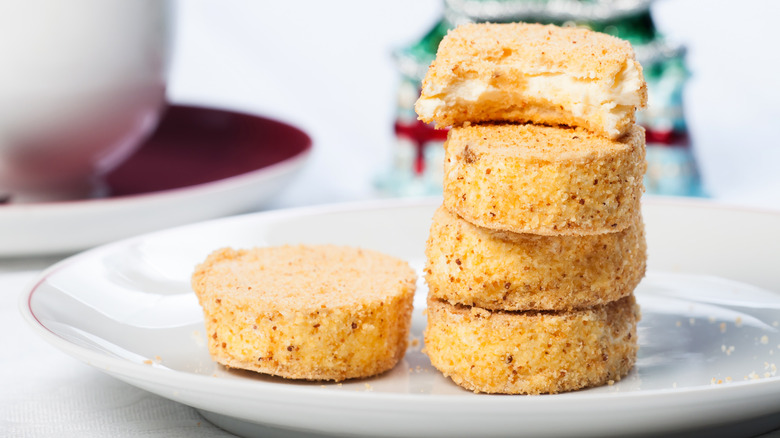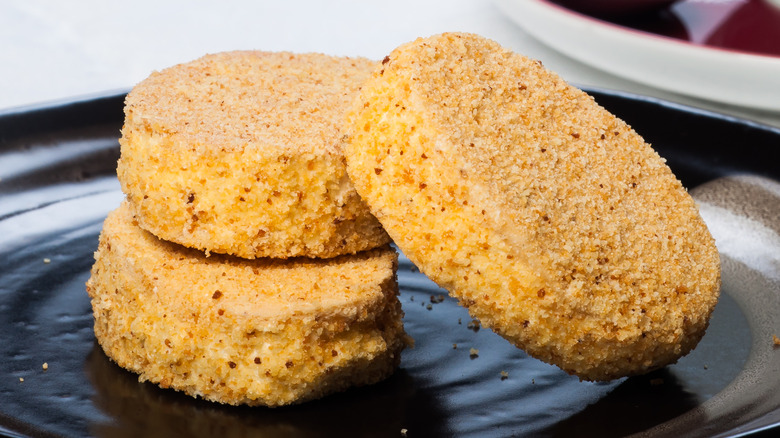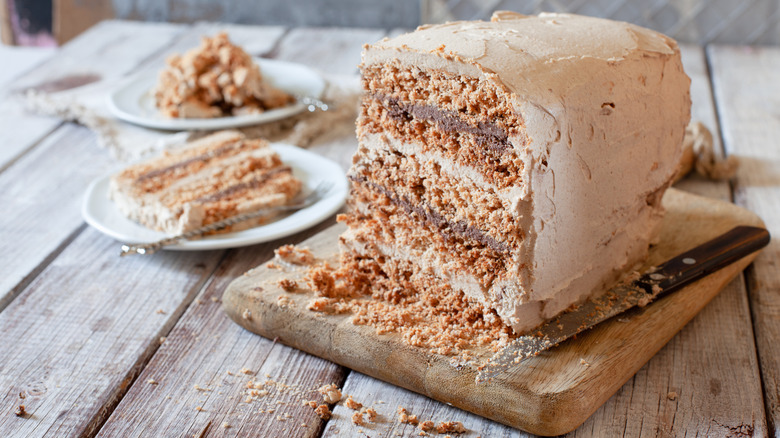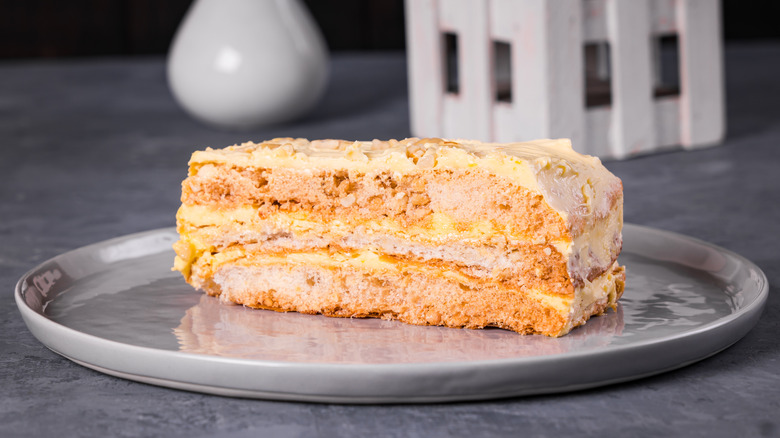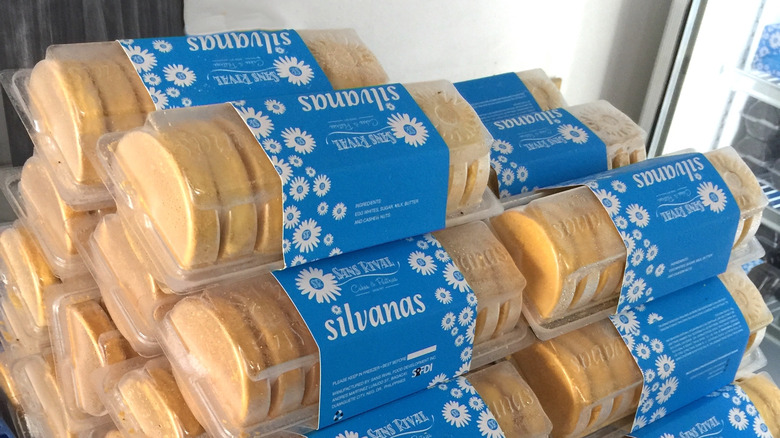Silvanas: The Filipino Cookies Based On French Dacquoise Cake
Visit any bakery in the Philippines, and there are four types of cookies you're sure to find — uraró, apas, rosquillo, and silvanas. But out of these four most popular Filipino cookies, the latter stands out from the rest (via Taste Atlas). Unlike regular cookies, silvanas are served cold or frozen and require refrigeration. Even though many Filipino foods have Spanish origins, silvanas are actually inspired by a French dessert: a cake called a dacquoise, as Kawaling Pinoy shares.
The Philippines was a Spanish colony from 1521 to 1898, hence the Spanish influence on the country's cuisine and culture, per NBC News. According to Beyond Sans Rival: French Influence on Philippine Gastronomy by Doreen Fernandez, historical records show a sharp increase in travel to France in 1890 (via Philippine Studies). Following the Paris Exposition that year, Filipinos began frequenting St. Jean de Luz for vacations, women began attending culinary school in France, and the food trends were subsequently introduced to Filipino restaurants and, by 1916, published in cookbooks. Those food trends eventually gave life to Filipino versions of French pastries, including pitisu (petits choux), mga trufas (truffles), and of course, silvanas, which have remained a popular part of Filipino cuisine.
What are silvanas?
Silvanas can be best described as a cookie sandwich. Per Kawaling Pinoy, a silvana consists of two round wafers with a thick layer of French buttercream in between. The batter is made by combining flour with cashews, beaten egg whites, cream of tartar, and sugar, then piping the mixture onto a baking sheet. The resulting wafers have a crisp outer shell and soft interior, similar to the texture of a macaron. Once the sandwiches are assembled, an additional layer of buttercream gets spread onto the outside of each cookie before it gets a final coating of ground cashews or graham cracker crumbs.
Cashews are the traditional choice given that the nut is native to the Philippines, but cookbook author Hannah Dela Cruz shares (via King Arthur Baking) that hazelnuts and pistachios substitute well, and even the buttercream can be flavored with chocolate or rosewater. However, one aspect of the recipe that can't be experimented with is the temperature, The Bailiwick Academy says. Silvanas melt quickly and lose their characteristic crunch if they're not refrigerated, so you'll want to enjoy them cold.
How do dacquoise and silvanas compare?
One is a French cake, and the other is a Filipino cookie, but dacquoise and silvanas have more in common than you might think. First, the ingredients are nearly identical. Comparing King Arthur Baking's silvanas recipe to a dacquoise recipe from Chef Iso, both have a beaten egg white base with sugar and cream of tartar. There are no leavening agents, as the meringue provides enough lift. Nuts also make up a large portion of the batter. For dacquoise, it's almond flour (or hazelnut flour mixed with cornstarch, per MasterClass), and for silvanas, cashews mixed with all-purpose flour. As for the filling, both use the same French buttercream.
Much of the difference lies in the shape and size. The wafers of a dacquoise are made on a larger scale. Each silvana is made with two cookie-sized ones, while a dacquoise consists of multiple that are larger and thicker. Up until the last step, the assembly follows the same process. The layers alternate between wafer and buttercream, with the remaining buttercream used to frost the outside. At this point, the dacquoise is dusted in powdered sugar, and silvanas are rolled in chopped nuts instead. After chilling in the refrigerator, both are ready to serve.
Silvanas are not the only Filipino dessert inspired by dacquoise
Silvanas are an obvious imitation of the dacquoise, but there's actually a similar Filipino dessert whose name ironically translates to "without rival" in French (via Taste Atlas). Sans rival, as it's called, is the cake version of silvanas, and is made exactly the same way as its cookie counterpart. The only difference between the two is that sans rival is bigger and served like a cake. For that reason, it more closely resembles the French dessert that inspired them both, but that's to be expected, given that sans rival was invented before silvanas.
Although the Philippine Studies journal notes that sans rival didn't appear in the original French-inspired cookbooks that were circulating the Philippines in the early 1900s, Taste Atlas reports it was around shortly after, between 1920 and 1930. Silvanas would come about sometime later, rendering the name of the previously "unrivaled" dessert inaccurate. Truth be told, however, comparing these dacquoise-inspired desserts is like comparing cupcakes to cakes — they're virtually the same aside from size.
Where to buy silvanas
According to Rappler, you can get silvanas practically anywhere in the Philippines, but the most popular place to get them is in Dumaguete City. The most well-known bakery there and across the Philippines is Sans Rival Cakes and Pastries. Per mybest, it has been the go-to spot for many years — since 1977, when Sans Rival Cakes and Pastries first opened, according to a picture of the original menu shared by Lynn En Route. The bakery's silvana recipe is the same one you'll now find throughout metro Manila because it's used by the ubiquitous House of Silvanas chain that opened in 1995. In 2010, House of Silvanas brought that same recipe to America, selling silvanas out of a Los Angeles bakery, Los Angeles Times reported.
House of Silvana's California location, which eventually moved from LA to Daly City (via House of Silvana), may be the most popular place to get silvanas in the U.S. Still, you can just as easily find the French-inspired treat at most local Filipino bakeries. These include The Silvanas Store and Crumbs.nd.Creams, as well as at chains like Goldilocks, one of the most favorited Filipino bakery chains (via Goldlilocks). This is only one of many examples of Filipino food sweeping America.
